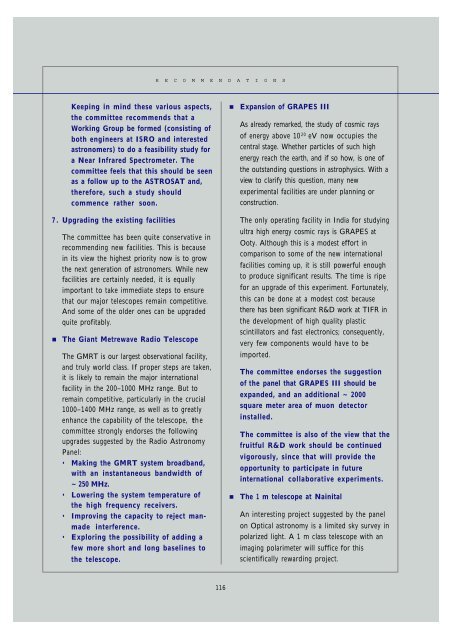2004 ASTRONOMY & ASTROPHYSICS - Indian Academy of Sciences
2004 ASTRONOMY & ASTROPHYSICS - Indian Academy of Sciences
2004 ASTRONOMY & ASTROPHYSICS - Indian Academy of Sciences
Create successful ePaper yourself
Turn your PDF publications into a flip-book with our unique Google optimized e-Paper software.
RECOMMENDATIONS<br />
Keeping in mind these various aspects,<br />
the committee recommends that a<br />
Working Group be formed (consisting <strong>of</strong><br />
both engineers at ISRO and interested<br />
astronomers) to do a feasibility study for<br />
a Near Infrared Spectrometer. The<br />
committee feels that this should be seen<br />
as a follow up to the ASTROSAT and,<br />
therefore, such a study should<br />
commence rather soon.<br />
7. Upgrading the existing facilities<br />
The committee has been quite conservative in<br />
recommending new facilities. This is because<br />
in its view the highest priority now is to grow<br />
the next generation <strong>of</strong> astronomers. While new<br />
facilities are certainly needed, it is equally<br />
important to take immediate steps to ensure<br />
that our major telescopes remain competitive.<br />
And some <strong>of</strong> the older ones can be upgraded<br />
quite pr<strong>of</strong>itably.<br />
• The Giant Metrewave Radio Telescope<br />
The GMRT is our largest observational facility,<br />
and truly world class. If proper steps are taken,<br />
it is likely to remain the major international<br />
facility in the 200–1000 MHz range. But to<br />
remain competitive, particularly in the crucial<br />
1000–1400 MHz range, as well as to greatly<br />
enhance the capability <strong>of</strong> the telescope, the<br />
committee strongly endorses the following<br />
upgrades suggested by the Radio Astronomy<br />
Panel:<br />
• Making the GMRT system broadband,<br />
with an instantaneous bandwidth <strong>of</strong><br />
~ 250 MHz.<br />
• Lowering the system temperature <strong>of</strong><br />
the high frequency receivers.<br />
• Improving the capacity to reject manmade<br />
interference.<br />
• Exploring the possibility <strong>of</strong> adding a<br />
few more short and long baselines to<br />
the telescope.<br />
• Expansion <strong>of</strong> GRAPES III<br />
As already remarked, the study <strong>of</strong> cosmic rays<br />
<strong>of</strong> energy above 10 20 eV now occupies the<br />
central stage. Whether particles <strong>of</strong> such high<br />
energy reach the earth, and if so how, is one <strong>of</strong><br />
the outstanding questions in astrophysics. With a<br />
view to clarify this question, many new<br />
experimental facilities are under planning or<br />
construction.<br />
The only operating facility in India for studying<br />
ultra high energy cosmic rays is GRAPES at<br />
Ooty. Although this is a modest effort in<br />
comparison to some <strong>of</strong> the new international<br />
facilities coming up, it is still powerful enough<br />
to produce significant results. The time is ripe<br />
for an upgrade <strong>of</strong> this experiment. Fortunately,<br />
this can be done at a modest cost because<br />
there has been significant R&D work at TIFR in<br />
the development <strong>of</strong> high quality plastic<br />
scintillators and fast electronics; consequently,<br />
very few components would have to be<br />
imported.<br />
The committee endorses the suggestion<br />
<strong>of</strong> the panel that GRAPES III should be<br />
expanded, and an additional ~ 2000<br />
square meter area <strong>of</strong> muon detector<br />
installed.<br />
The committee is also <strong>of</strong> the view that the<br />
fruitful R&D work should be continued<br />
vigorously, since that will provide the<br />
opportunity to participate in future<br />
international collaborative experiments.<br />
• The 1 m telescope at Nainital<br />
An interesting project suggested by the panel<br />
on Optical astronomy is a limited sky survey in<br />
polarized light. A 1 m class telescope with an<br />
imaging polarimeter will suffice for this<br />
scientifically rewarding project.<br />
116
















